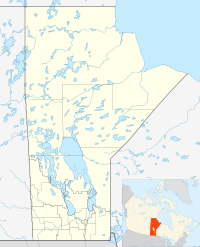Delta Marsh facts for kids
Quick facts for kids
Designations
|
|
| Official name: Delta Marsh | |
| Designated: | 24 May 1982 |
|---|---|
| Reference #: | 238 |
Delta Marsh is a very large wetland area in Manitoba, Canada. It's located near the south shore of Lake Manitoba. The marsh is about 24 kilometers north of Portage la Prairie.
This amazing marsh stretches for almost 30 kilometers along the lake. It can be up to 4 kilometers wide. Delta Marsh is made up of many shallow bays that are connected. A wooded ridge separates these bays from Lake Manitoba. This ridge is like a natural wall, 300 to 600 meters wide.
Even though it's called Delta Marsh, it's not a river delta anymore. Long ago, about 2500 years ago, it was the delta of the Assiniboine River. That river used to flow into Lake Manitoba. Today, the Assiniboine River flows east past Lake Manitoba. It then joins the Red River in Winnipeg.
The marsh is found in the northern part of the Rural Municipality of Portage la Prairie.
Contents
Animals and Plants of Delta Marsh
Delta Marsh is super important for wildlife. Many animals use it for breeding and as a stopover during migration. It's especially busy with waterfowl (like ducks and geese) and songbirds. They either live there or visit during their long journeys. The wooded ridge next to the marsh is also a path for passerine birds as they migrate.
Hunting and Wildlife Management
Hunting is allowed in some parts of the marsh during autumn. This is for sportsmen and for First Nations people year-round. The Delta Marsh Wildlife Management Area helps control hunting. This makes sure the marsh environment stays safe.
The main birds hunted are Canada geese, mallard ducks, and snow geese. These birds feed in the marsh and nearby grain fields. Canada geese and mallards also breed in the marsh. Snow geese only visit during migration. Hunting helps the local economy. Other animals like white-tailed deer are also hunted. Beaver and other fur-bearing animals are trapped for their fur.
How People Use Delta Marsh
Most of Delta Marsh is still very natural and untouched. However, some people have built cottages on the wooded ridge. Delta Beach, which is on the lake side of the ridge, is a popular place for swimming in summer. The road to the beach crosses a drier part of the marsh. This means it doesn't disturb the marsh habitat too much.
The Assiniboine River Floodway
One big human-made change to the marsh is the Assiniboine River Floodway. This floodway crosses the marsh near its western end. It helps control floods from the Assiniboine River. When there's a lot of water, the floodway sends it directly into Lake Manitoba. This protects Portage la Prairie and Winnipeg from spring floods. People still talk about how this floodway affects the marsh's environment.
Research and Conservation
The Delta Waterfowl Research Station started in 1938. It's located east of Delta Beach. Its main job was to study waterfowl. Later, in 1966, the University of Manitoba opened the Delta Marsh Field Station. This was a place for teaching and research. Sadly, the field station closed in 2011. This happened after a huge flood on Lake Manitoba damaged its buildings.
The Delta Waterfowl Foundation is a global group that studies and protects waterfowl. It was inspired by and named after Delta Marsh. Delta Marsh is also recognized as a Wetland of International Importance. This means it's a special wetland protected under the Ramsar Convention.
Images for kids
-
Lake Manitoba From Delta Marsh Field Station















